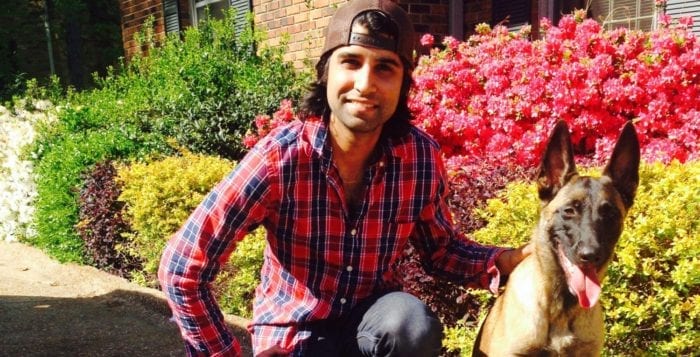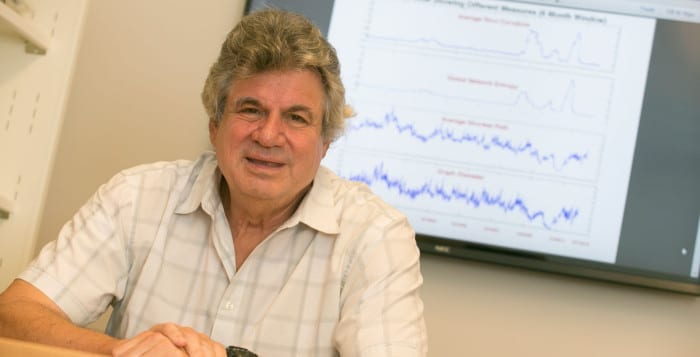By Daniel Dunaief
Romeil Sandhu has had a busy year.
Last fall, the U.S. Air Force awarded him a $450,000 three-year grant, called the Young Investigator Research Program. At the beginning of this year, Sandhu won a $500,000 National Science Foundation Career Award.
The assistant professor in the Department of Biomedical Informatics at Stony Brook University is working in several directions on basic research that could help with everything from network security to autonomous cars.
The awards are a “tremendous accomplishment,” Allen Tannenbaum, a distinguished professor of computer science and applied mathematics/statistics at SBU, explained in an email. Sandhu won the career award on his “first try, which is very unusual. The Air Force award is a very high honor for a young researcher.”
Tannenbaum was Sandhu’s doctoral thesis adviser at Georgia Tech. Tannenbaum recruited Sandhu to join Stony Brook University and described Sandhu’s work as going in a “very promising direction.”
The Air Force funding is a new direction in which Sandhu is developing a theory around how to incorporate user input in three-dimensional autonomous systems that rely on two-dimensional imaging information.
An example of this, Sandhu explained, is where a soldier might make judgments maneuvering a vehicle around potentially deadly situations. His work involves translating three-dimensional interactive feedback controls based on two-dimensional imaging systems.
“When you take a video of a car, it’s in two dimensions,” he explained. The computer link between the collected images and the reality relies on geometric properties.
With most autonomous computer systems, a human is involved in the process, to prepare for what is called the “unknown unknown.” That is a term used to describe situations in which there is no way to predict all possible events.
Through his Air Force work, Sandhu ideally would like to seek greater autonomy for some of these self-directed systems. Removing human input entirely, however, generates a risk that may be too great. That is the case in cancer treatment as well as the systems used to protect soldiers. The work he is doing with the Air Force explores how to fuse human and computer-assisted decision making.
The NSF award, meanwhile, will use the confluence of geometry and control to explore vulnerability in time-varying networks. Sandhu is tackling problems in social systems, communication systems and cancer biology and biomedical informatics.
“We can devise this idea of a network, which is the same way with cancer and proteins,” he said. One protein sends a signal to another, causing a cascade of reactions that often promote cancer.
Sandhu is interested in how microfluctuations can pave the way to larger disruptions. In the social setting, such information may infect individuals or groups and such dynamics may allow it to influence macroscopic audiences.
“The prevailing idea is that there exist several changes that pave the way to a larger catastrophic failure,” he explained in an email.
The grant is designed to exploit everything that can be modeled as a part of a network, to understand their vulnerability. Viral information and trending stories, Sandhu said, might have one dynamic, while conspiracy theories might have another. He would like to see how such information gains traction and spreads.
The way people interact occurs through multiple networks. Sandhu is studying how models can exploit real-world behavior. Geometry, he suggests, can begin to assist on more complex modeling problems that are time varying and multilayered.
When he describes how he studies systems such as cancer, he likens the process to a waterbed. A drug or therapy may knock out a specific gene, which could limit cancer’s growth. When that gene changes, however, it creates a wave along the bed, enabling another potential genetic process to occur. While it has a more precise definition in control, it is akin to sitting on a waterbed in suppressing one sequence only to give rise to another.
Sandhu, who arrived at Stony Brook University in 2016, grew up in Huntsville, Alabama, and then spent over a decade going to school in Georgia, where he earned his doctorate at Georgia Tech.
In some ways, Sandhu’s Huntsville background, which includes lettering in high school soccer for four years as a center midfielder, is similar to one of the challenges in perception he studies through his work.
“Think of me as one person in a network,” he said. “In a lot of the research we look at, we want to know how microfluctuations such as myself give way to a larger perception.”
Sandhu explained that the general perception of Huntsville and Alabama is different from his experience.
Most people are surprised that Huntsville has the second largest research park in the nation, at Cummings Research Park. Huntsville also has numerous aerospace companies.
The city generally ranks highly as one of the more educated in the country, he said. This is due in large part to the tech community that supports the government. The town is largely influenced by NASA and the surrounding military aerospace community, which Sandhu believes impacted his worldview, career path and research initiatives.
Indeed, one of the goals Sandhu has for his NSF grant is to help educate the high school students of people serving in the military. He said he appreciated the military families who were such an integral part of his upbringing.
Sandhu has two doctoral students and two master’s students in his lab. He also plans to participate in the Simons Summer Research Program at SBU where he will add a high school student. He is excited about the next phase of his research.
“The best part is the challenges that lie ahead,” he explained in an email. “Whether it is targeted therapy and cancer research, social computing and/or interactive computing, we are just beginning to understand very complex issues. Our hope is that we can make a contribution.”






